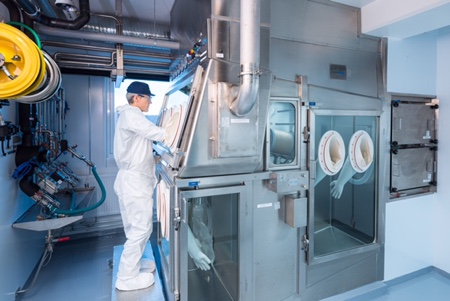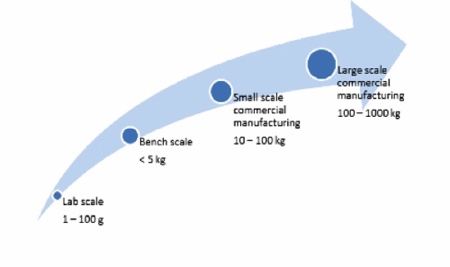Advanced technologies that allow the delivery of drug substances directly to the site of action – tumour cells, infected cells, damaged organs – rather than acting systemically are leading to drugs with increased safety and efficacy. This approach also enables the use of highly potent active pharmaceutical ingredients (HPAPIs) that previously were not reasonable candidates due to their toxicity to the patient when delivered using conventional approaches.
Pharmaceutical manufacturers are in need of capacity suitable for the safe production, storage and transport of a growing range of potent compounds
Consequently, the HPAPI market is growing faster than the overall API market, and the percentage of drug candidates classified as HPAPIs is increasing. Pharmaceutical manufacturers are in need of capacity suitable for the safe production, storage and transport of a growing range of potent compounds. Contract service providers – both contract development and manufacturing organisations (CDMOs) and CMOs – can help, but drug companies should only consider partnering with firms that have a history of successfully producing and handling HPAPIs and continually investing in the most advanced safety equipment, systems and processes.
Highly potent market growth
Highly potent small-molecule and biologic drugs are typically considered to be those APIs that have an occupational exposure limit (OEL) of ≤10g/m3 of air as an 8-hour time-weighted average. Many candidates under development today have significantly lower OELs. They are attractive in part because they require relatively low doses, which translates to reduced exposure to impurities.
Those that can be delivered in a highly targeted fashion are even more desirable because they minimise unwanted side-effects and allow for the use of highly potent compounds that otherwise would cause too much damage to healthy cells. Grand View Research1 estimates that the HPAPI market will increase significantly from US$12bn in 2014 to $25.86bn in 2022, which corresponds to an average annual growth rate of 14.4%.
While the majority of highly potent drugs under development are oncology treatments – and growth in this segment has been a key driver for HPAPI market expansion – there are other classes of highly potent APIs, such as hormones, narcotics, and retinoids.
Advances in HPAPI manufacturing technologies are also contributing to the expansion of the market. In particular, antibody-drug conjugates (ADCs) are now the fastest growing segment of the HPAPI market because they enable the delivery of cytotoxic drugs to targeted cells. Composed of antibodies, ADCs are designed to bind to specific antigen-expressing cells (e.g. tumour cells) that are linked to highly potent, small-molecule APIs (payloads). The linker is designed to release the payload only once the antibody reaches the targeted cells.
Growth of the HPAPI market is also in part fuelled by desire in the industry to adopt the safest approaches to manufacturing APIs and formulated drug products. As the number of more potent drug candidates has increased, both sponsor companies and CMOs have begun to classify their new molecular entities to a higher containment category to ensure the appropriate protection for workers.
While highly potent drugs such as ADCs can be very beneficial to patients, if not handled correctly their high potency could pose a significant safety risk to plant operators involved in their manufacture, packaging and transport. Workers must be protected from any level and all possible routes of exposure. In addition, exposure to the general environment and cross-contamination with other products manufactured in the same facility must be avoided.
As a result, significant investment in specialised equipment designed to separate workers from potent compounds and minimise manual operations, systems to control air pressure and transfer operations, appropriate personal protective equipment (PPE), and extensive safety procedures and training programmes are necessary.
Continuous investment
As important, a commitment to continuous investment in equipment and technologies is crucial to ensure that the most advanced safety systems are in place for the protection of operators, regardless of the potency of the substances they are handling. A comprehensive HPAPI manufacturing programme requires extensive planning, the use of risk management and risk assessment tools, a mechanism for determining which compounds are suitable for manufacture in a given facility, and a company culture focused on safety.
Careful facility and equipment design is paramount, as are experts in engineering, toxicology and industrial hygiene, and effective collaboration between all involved in the production and handling of the HPAPIs. Employees must have an understanding of both the hazards and risks, appropriate training and education, and a commitment to follow all safety procedures.

Employees must have an understanding of the hazards and risks, appropriate training and education, and a commitment to follow all safety procedures
Systems must be in place for managing the risks presented by potent compounds throughout entire project lifetimes – from the time they initially arrive with limited information on their potency to final API or drug product manufacture and shipment and including procedures for cleaning and waste management, equipment maintenance, analytical testing and warehouse management. However, with the appropriate safety measures in place (engineering controls, written procedures, PPE, and occupational medical surveillance programmes) as part of such a comprehensive system, the hazards and risks posed by HPAPIs can be effectively minimised and workers and the environment effectively protected.
Not surprisingly, implementation of a successful HPAPI manufacturing strategy takes significant time and investment. The rapidly growing HPAPI market is attracting the interest of numerous CDMOs/CMOs. Many of these companies have the necessary equipment in place, but lack the skills, expertise and experience required to reliably and safely manufacture HPAPIs. This situation increases the challenge that sponsor companies face when selecting service providers for their HPAPI projects, as well as considering traditional performance metrics such as quality, on-time delivery, regulatory history and overall financial stability.
Track record
Pharmaceutical companies seeking CMO/CDMO partners for HPAPI manufacture and/or formulation must thoroughly evaluate not only their HPAPI manufacturing strategies, but also their track record for both the safe and successful completion of HPAPI projects and continued investment in state-of-the-art isolation, automation, and other relevant technologies.
Pharmaceutical companies seeking CMO/CDMO partners for HPAPI manufacture must thoroughly evaluate not only their HPAPI manufacturing strategies, but also their track record
Fermion, which was formed in 1970 as a 50:50 joint venture between Rikkihappo (now Kemira) and Orion, produces generic APIs, intermediates and active ingredients, including HPAPIs, for both Orion and external customers at its facilities in Finland, which have been FDA inspected and approved since 1979. To date, Fermion has commercialised or is awaiting approval of a total of 10 innovative APIs. With respect to HPAPIs, the company has a long tradition of manufacturing oncology products, beginning with the production of methotrexate in the early 1980s. Since that time, it has actively expanded its HPAPI product portfolio.
Fermion’s Oulu site is dedicated to the production of large- and small-scale HPAPIs to a containment level of 0.1µg/m3, and the company also has R&D-scale HPAPI systems at its laboratories in Espoo. Its first modern high-containment module was inaugurated in 2004 with split valve technologies, and over the past 12 years it has invested heavily in upgrading other HPAPI production facilities. The latest modules were installed in 2013 and 2015 and include highly automated systems.
The facility opened in 2013 is designed for the production of OEL Class V drugs and is equipped with two distinct high potency processing modules: one for cytotoxic compounds and the other for non-cytotoxic HPAPIs, such as sedatives and respiratory products. Process automation at Fermion, including in the HPAPI production modules, has been integrated with data collection and the company SAP enterprise resource planning system. The result of this has been increased worker safety, significant cost and labour savings, higher productivity, and waste minimisation. Furthermore, the company has been able to bring process optimisation, troubleshooting, and deviation investigation activities to a more advanced level, which has contributed to more consistent processes and higher quality products.

Figure 1: Fermion’s HPAPI batch size scale
Fermion has also made investments in laboratory facilities; specifically in 2015, a bench-scale unit at Espoo for the production of compounds requiring high containment up to 0.2µg/m3 was nearly tripled from 200m2 to 580m2. The unique unit is designed like a plant and enables efficient and reliable scale-up work using a production-type Honeywell data acquisition system. It includes three isolators for dispensing, filtration and other operations (drying, milling, homogenisation), split valve technology for charging, and high-containment Nutsche filters. In addition, a Hastelloy 30L reactor has been installed that can operate at pressures up to 30 bar and temperatures above 200°C.
The year 2018 will mark the start of a new era for the company as Fermion’s Hanko plant in the south of Finland starts operating new API manufacturing facilities, including 76m3 reactor space incremental to the company’s current total reactor volume of 320m3. There will be a reactor space of 25m3 for OEB5 compounds (containment level of ≤1µg/m3) and the rest of the new capacity is equipped for compounds requiring a containment level of ≤10µg/m3.
Fermion’s strategy also includes the assignment of substances with limited toxicology data to at least the 10–100µg/m3 containment level. If the structure indicates similarity with a more potent compound, such as an HPAPI, a higher ranking 1–10µg/m3 or even the highest (0.1–1µg/m3) level is adopted if the corresponding API is in that range. APIs with little known property data are generally classified as substances requiring a containment level of 1–10µg/m3.
Compounds with known toxicology data are assigned to categories considering their toxicological assessments and/or lowest daily doses and characteristics. The containment categories are listed in Table 1.
| Table 1: Containment categories employed at Fermion | |
| Category | Occupational exposure limit (µg/m3/8h) |
| OEB 5 | 0.1 – 1 |
| OEB 4 | 1 – 10 |
| OEB 3 | 10 – 100 |
| OEB 2 | 100 – 1000 |
| OEB 1 | 1000 – |
In conclusion, pharmaceutical companies are focusing on the development of highly potent APIs given their numerous therapeutic advantages. Production of such compounds poses hazards and risks to workers and the environment, however, and many sponsor companies are turning to CMOs and CDMOs for assistance with the development, manufacture and distribution of HPAPIs and the formulated drug products based on them. Only CMOs/CDMOs with established, successful HPAPI manufacturing strategies, a history of continuous investment in the most innovative and advanced containment technologies, as well as a demonstrated capability to produce high-quality HPAPIs safely and on time should be considered.
Reference
1. www.grandviewresearch.com




